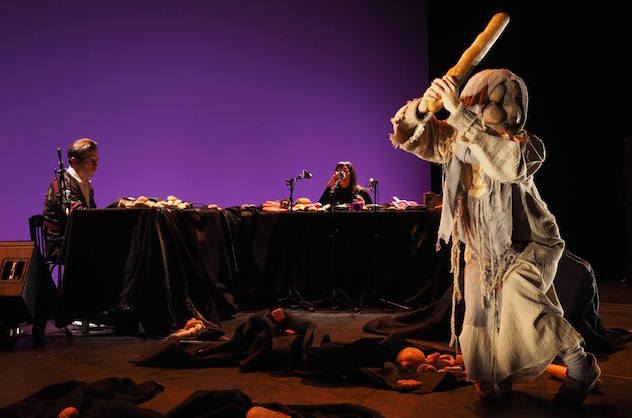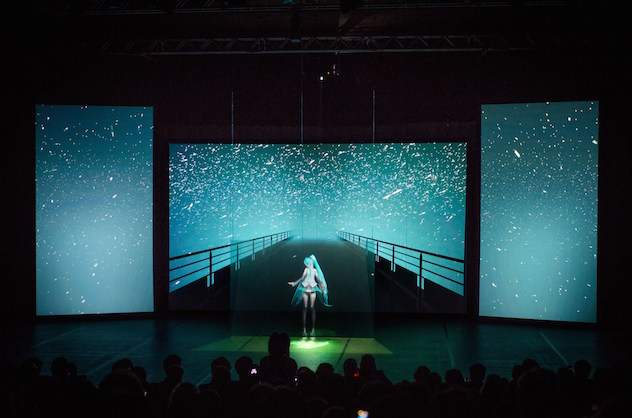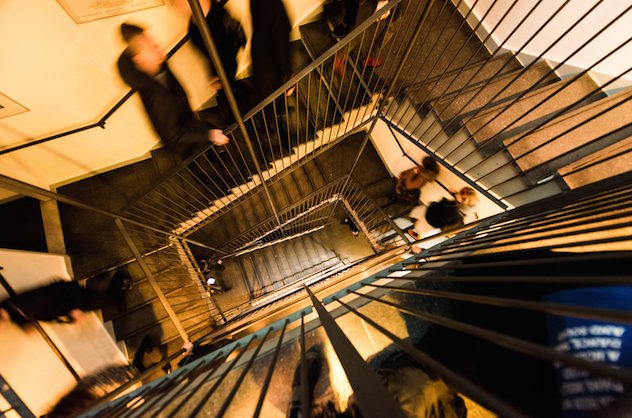- Berlin's CTM is one of the most intriguing electronic music and art festivals around, showcasing artists whose primary focus is sound innovation. The programme is loosely framed around a curatorial theme, which this year was New Geographies. It proved a timely, worthwhile concept to explore. Rabih Beaini, an excellent choice of co-curator, had this to say about it: "Let's throw down these borders, not only musically but mentally." Running for ten days from January 29th through February 7th, CTM felt like a proper exploration of experimental terrain where the only borders that existed were physical ones—that is, whether or not you had the right pass or ticket, or arrived early enough to get a spot.
Too often artists who happen to identify as female, or who are not straight white males, are pigeonholed or tokenized on festival lineups. This was not the case at CTM. Pauline Oliveros, a central figure in American experimental music, made four appearances, there was an all-female lineup in Panorama Bar on the Thursday night, and Anna Homler's Breadwoman made a comeback. One of the festival's most talked about performances featured Hatsune Miku, a perpetually 16-year old virtual Japanese popstar, with music by Laurel Halo. It was promising to see so many women and people of colour on paper, but even better to see the curation unfold successfully at each event.
 Collaborations have always been central to CTM. Tokyo-based noise master Keiji Haino and guitarist Kazuhisa Uchihashi teamed up with Indonesian duo Senyawa for a Japanese-Javanese jam session, with vocal chords and guitar strings vibrating in mysterious ways. At its peak, it felt simultaneously discordant and melodic. Also part of the Coordinates series was a performance that paired the live hypnagogic shoegaze of Love Cults with a film by Alina Filippova. The duo's dark and dreamy synthesis of cut-up vocals and pulsating bass were an ideal soundtrack to Filippova's vignettes of Russian youth. A teenage girl, one minute dancing in a field and moments later dragging her limbs through the mud, did so with the same measure of euphoria. This notion of the beauty found in absurd banality was echoed in Buttechno's live A/V set—grainy footage of concrete Russian apartments were traversed by a mysterious ski-mask wearing protagonist, who ended up being Buttecnho himself jamming on an AKAI sampler in a cave.
Collaborations have always been central to CTM. Tokyo-based noise master Keiji Haino and guitarist Kazuhisa Uchihashi teamed up with Indonesian duo Senyawa for a Japanese-Javanese jam session, with vocal chords and guitar strings vibrating in mysterious ways. At its peak, it felt simultaneously discordant and melodic. Also part of the Coordinates series was a performance that paired the live hypnagogic shoegaze of Love Cults with a film by Alina Filippova. The duo's dark and dreamy synthesis of cut-up vocals and pulsating bass were an ideal soundtrack to Filippova's vignettes of Russian youth. A teenage girl, one minute dancing in a field and moments later dragging her limbs through the mud, did so with the same measure of euphoria. This notion of the beauty found in absurd banality was echoed in Buttechno's live A/V set—grainy footage of concrete Russian apartments were traversed by a mysterious ski-mask wearing protagonist, who ended up being Buttecnho himself jamming on an AKAI sampler in a cave.
 Still Be Here, the commissioned performance featuring virtual popstar Hatsune Miku, epitomized what CTM is about. The well-executed middlebrow experience, expertly scored by Halo, explored the sonic, visual and virtual topography of the uncanny valley and transcended the hype surrounding it. Other performances didn't quite live up to expectations, Floating Points's among them. Sam Shepherd has successfully acquired a loyal following of elated jazz dads, who cheered every time the riff of the next song came in, but I couldn't help feeling that the ensemble sounded like a mix of Radiohead and Pink Floyd, just with a top-of-the-line analog synthesizer. Unsatisfied, I left Floating Points early to catch most of Beatrice Dillon's opening set at Watergate, appreciating the dubby change of scenery. There were only a few devoted dancers at first, but then she dropped Laurel Halo's "Situation" and the floor swelled.
There were many other insane dance floor moments across the festival, several of which happened in rapid succession at Berghain and Panorama Bar earlier in the programme. Nepalese-Tibetan producer Aïsha Devi delivered powerhouse vocals over throbbing bass on Thursday night, flanked by dancers and Tianzhuo Chen's incredibly colourful visuals. Next was American rapper Le1f, whose flawless vocal delivery and catchy hooks had much of the Berghain crowd twerking. Upstairs at Panorama Bar, the night played out in more regular fashion, though with more sub bass and less four-to-the-floor beats than usual. It was here that Jlin performed a live mix of her sample-free footwork, which I couldn't help but stick around for. The energy was palpable, the crowd was loving it, and Jlin was smiling wildly and dancing along. Whether it was 3:30 AM on a Thursday night in Panorama Bar, Friday evening at an art museum or Sunday night at Watergate, this year's CTM presented ample sonic geographies to wander through. Here's hoping the diverse, progressive lineup wasn't just an anomaly and that more festivals and club promoters take heed and follow suit.
Still Be Here, the commissioned performance featuring virtual popstar Hatsune Miku, epitomized what CTM is about. The well-executed middlebrow experience, expertly scored by Halo, explored the sonic, visual and virtual topography of the uncanny valley and transcended the hype surrounding it. Other performances didn't quite live up to expectations, Floating Points's among them. Sam Shepherd has successfully acquired a loyal following of elated jazz dads, who cheered every time the riff of the next song came in, but I couldn't help feeling that the ensemble sounded like a mix of Radiohead and Pink Floyd, just with a top-of-the-line analog synthesizer. Unsatisfied, I left Floating Points early to catch most of Beatrice Dillon's opening set at Watergate, appreciating the dubby change of scenery. There were only a few devoted dancers at first, but then she dropped Laurel Halo's "Situation" and the floor swelled.
There were many other insane dance floor moments across the festival, several of which happened in rapid succession at Berghain and Panorama Bar earlier in the programme. Nepalese-Tibetan producer Aïsha Devi delivered powerhouse vocals over throbbing bass on Thursday night, flanked by dancers and Tianzhuo Chen's incredibly colourful visuals. Next was American rapper Le1f, whose flawless vocal delivery and catchy hooks had much of the Berghain crowd twerking. Upstairs at Panorama Bar, the night played out in more regular fashion, though with more sub bass and less four-to-the-floor beats than usual. It was here that Jlin performed a live mix of her sample-free footwork, which I couldn't help but stick around for. The energy was palpable, the crowd was loving it, and Jlin was smiling wildly and dancing along. Whether it was 3:30 AM on a Thursday night in Panorama Bar, Friday evening at an art museum or Sunday night at Watergate, this year's CTM presented ample sonic geographies to wander through. Here's hoping the diverse, progressive lineup wasn't just an anomaly and that more festivals and club promoters take heed and follow suit.
 Photo credit: Camille Blake
Photo credit: Camille Blake
 Collaborations have always been central to CTM. Tokyo-based noise master Keiji Haino and guitarist Kazuhisa Uchihashi teamed up with Indonesian duo Senyawa for a Japanese-Javanese jam session, with vocal chords and guitar strings vibrating in mysterious ways. At its peak, it felt simultaneously discordant and melodic. Also part of the Coordinates series was a performance that paired the live hypnagogic shoegaze of Love Cults with a film by Alina Filippova. The duo's dark and dreamy synthesis of cut-up vocals and pulsating bass were an ideal soundtrack to Filippova's vignettes of Russian youth. A teenage girl, one minute dancing in a field and moments later dragging her limbs through the mud, did so with the same measure of euphoria. This notion of the beauty found in absurd banality was echoed in Buttechno's live A/V set—grainy footage of concrete Russian apartments were traversed by a mysterious ski-mask wearing protagonist, who ended up being Buttecnho himself jamming on an AKAI sampler in a cave.
Collaborations have always been central to CTM. Tokyo-based noise master Keiji Haino and guitarist Kazuhisa Uchihashi teamed up with Indonesian duo Senyawa for a Japanese-Javanese jam session, with vocal chords and guitar strings vibrating in mysterious ways. At its peak, it felt simultaneously discordant and melodic. Also part of the Coordinates series was a performance that paired the live hypnagogic shoegaze of Love Cults with a film by Alina Filippova. The duo's dark and dreamy synthesis of cut-up vocals and pulsating bass were an ideal soundtrack to Filippova's vignettes of Russian youth. A teenage girl, one minute dancing in a field and moments later dragging her limbs through the mud, did so with the same measure of euphoria. This notion of the beauty found in absurd banality was echoed in Buttechno's live A/V set—grainy footage of concrete Russian apartments were traversed by a mysterious ski-mask wearing protagonist, who ended up being Buttecnho himself jamming on an AKAI sampler in a cave.
 Still Be Here, the commissioned performance featuring virtual popstar Hatsune Miku, epitomized what CTM is about. The well-executed middlebrow experience, expertly scored by Halo, explored the sonic, visual and virtual topography of the uncanny valley and transcended the hype surrounding it. Other performances didn't quite live up to expectations, Floating Points's among them. Sam Shepherd has successfully acquired a loyal following of elated jazz dads, who cheered every time the riff of the next song came in, but I couldn't help feeling that the ensemble sounded like a mix of Radiohead and Pink Floyd, just with a top-of-the-line analog synthesizer. Unsatisfied, I left Floating Points early to catch most of Beatrice Dillon's opening set at Watergate, appreciating the dubby change of scenery. There were only a few devoted dancers at first, but then she dropped Laurel Halo's "Situation" and the floor swelled.
There were many other insane dance floor moments across the festival, several of which happened in rapid succession at Berghain and Panorama Bar earlier in the programme. Nepalese-Tibetan producer Aïsha Devi delivered powerhouse vocals over throbbing bass on Thursday night, flanked by dancers and Tianzhuo Chen's incredibly colourful visuals. Next was American rapper Le1f, whose flawless vocal delivery and catchy hooks had much of the Berghain crowd twerking. Upstairs at Panorama Bar, the night played out in more regular fashion, though with more sub bass and less four-to-the-floor beats than usual. It was here that Jlin performed a live mix of her sample-free footwork, which I couldn't help but stick around for. The energy was palpable, the crowd was loving it, and Jlin was smiling wildly and dancing along. Whether it was 3:30 AM on a Thursday night in Panorama Bar, Friday evening at an art museum or Sunday night at Watergate, this year's CTM presented ample sonic geographies to wander through. Here's hoping the diverse, progressive lineup wasn't just an anomaly and that more festivals and club promoters take heed and follow suit.
Still Be Here, the commissioned performance featuring virtual popstar Hatsune Miku, epitomized what CTM is about. The well-executed middlebrow experience, expertly scored by Halo, explored the sonic, visual and virtual topography of the uncanny valley and transcended the hype surrounding it. Other performances didn't quite live up to expectations, Floating Points's among them. Sam Shepherd has successfully acquired a loyal following of elated jazz dads, who cheered every time the riff of the next song came in, but I couldn't help feeling that the ensemble sounded like a mix of Radiohead and Pink Floyd, just with a top-of-the-line analog synthesizer. Unsatisfied, I left Floating Points early to catch most of Beatrice Dillon's opening set at Watergate, appreciating the dubby change of scenery. There were only a few devoted dancers at first, but then she dropped Laurel Halo's "Situation" and the floor swelled.
There were many other insane dance floor moments across the festival, several of which happened in rapid succession at Berghain and Panorama Bar earlier in the programme. Nepalese-Tibetan producer Aïsha Devi delivered powerhouse vocals over throbbing bass on Thursday night, flanked by dancers and Tianzhuo Chen's incredibly colourful visuals. Next was American rapper Le1f, whose flawless vocal delivery and catchy hooks had much of the Berghain crowd twerking. Upstairs at Panorama Bar, the night played out in more regular fashion, though with more sub bass and less four-to-the-floor beats than usual. It was here that Jlin performed a live mix of her sample-free footwork, which I couldn't help but stick around for. The energy was palpable, the crowd was loving it, and Jlin was smiling wildly and dancing along. Whether it was 3:30 AM on a Thursday night in Panorama Bar, Friday evening at an art museum or Sunday night at Watergate, this year's CTM presented ample sonic geographies to wander through. Here's hoping the diverse, progressive lineup wasn't just an anomaly and that more festivals and club promoters take heed and follow suit.
 Photo credit: Camille Blake
Photo credit: Camille Blake